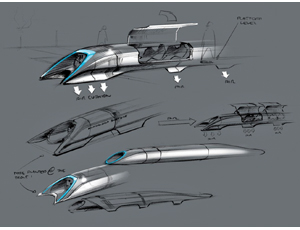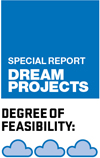Dream Projects: Hyperloop's Creator Stands By the Physics

Hyperloop is a concept involving passenger-filled capsules traveling through low-pressure tubes at high speed between Los Angeles and San Francisco.
Elon Musk, president Tesla Motors and SpaceX, dubs his brainchild, Hyperloop, a “fifth mode of transportation.” The concept is to travel via passenger-filled capsules going hundreds of miles an hour through 88-in.-dia low-pressure pipes atop pylons and powered by solar panels.
 |
In Musk’s 57-pg document detailing the idea, a capsule car using a linear electric motor accelerates 28 reclining passengers to a top speed of 760 mph, and then coasts 90% of the proposed 350-mile trip from San Francisco to Los Angeles. Musk admits to leaning on the imaginations of Robert H. Goddard of NASA fame, the RAND Corp., Santa Monica, Calif. and ET3 Global Alliance, Longmont, Colo., all of which presented studies of high-speed transit via depressurized tubes.
The Hyperloop proposal distinguishes its low-pressure tubes from the evacuated tubes of previous ideas, because of the massive difficulty in attaining a true vacuum over such a distance. Musk says pressure will be “set to a level where standard commercial pumps could easily overcome an air leak,” which means some air must be displaced by the capsule. Musk solves this with a compressor built into the nose of the capsule to ingest what little air is in the tube—equivalent to flying above 150,000 feet altitude, according to the report.
Goddard and more recently Daryl Oster, president ET3, tout capsules levitating on magnets, but Musk argues, “the cost associated with material and construction [of magnetic levitation track] is prohibitive.” His report claims the compressor’s ingested air can act as propulsion during the trip and as suspension, carrying the capsule on “air bearings”.
Musk offers his proposal to the engineering community at large to develop Hyperloop or its like. Since the document’s August 12, 2013 release, engineers, 3D designers, physicists and mathematicians criticize and add to the project. One area of debate is Musk’s claimed construction cost of $6-billion for the entire project.
“The substructure costs alone for elevated structure, over the entire length of the alignment, is enormous,” says Theodore Zoli, national bridge chief engineer, HNTB Corp., Kansas City, Mo. But Zoli adds that the tube doesn’t need to be on piers,” particularly if it is in the median of I-5,” as Musk suggested. Jordan Brandt, technology futurist, Autodesk, designed a 3D version of Musk’s proposed track and tinkerers continue to post Youtube.com videos of their tweaks to the project.
The Hyperloop report outlines five known holes in its initial design and asks for help filling them, including detailed control mechanisms for the capsules, station designs for loading and unloading passengers, cost/benefit of Hyperloop to magnetic levitation systems and sub-scale testing based on optimized design.
Oster of ET3 claims to have solved all the outlined problems in his alternate design, which boasts smaller, 51-in.-dia pipes and detailed outlines of proposed tracks. Oster says he is in proceedings to attain right of passage through three miles of Federally-owned land in Barstow, Calif. to test his ET3 design.
As of today, Hyperloop is relegated to a fictional world. Scientific American magazine published a science fiction story by Goddard in 1909 detailing his evacuated tube idea and followed by a footnote from the editor that says, all things mechanical aside, “the absolute limit of rapid transit,” is determined by what the human body can withstand. The thought is that the body can travel at any speed given that it reaches top speed at a reasonable velocity and slows to a halt at a reasonable velocity. The editors of the 1909 magazine say, “The highest speed attainable would therefore be proportional to the distance traversed.”

